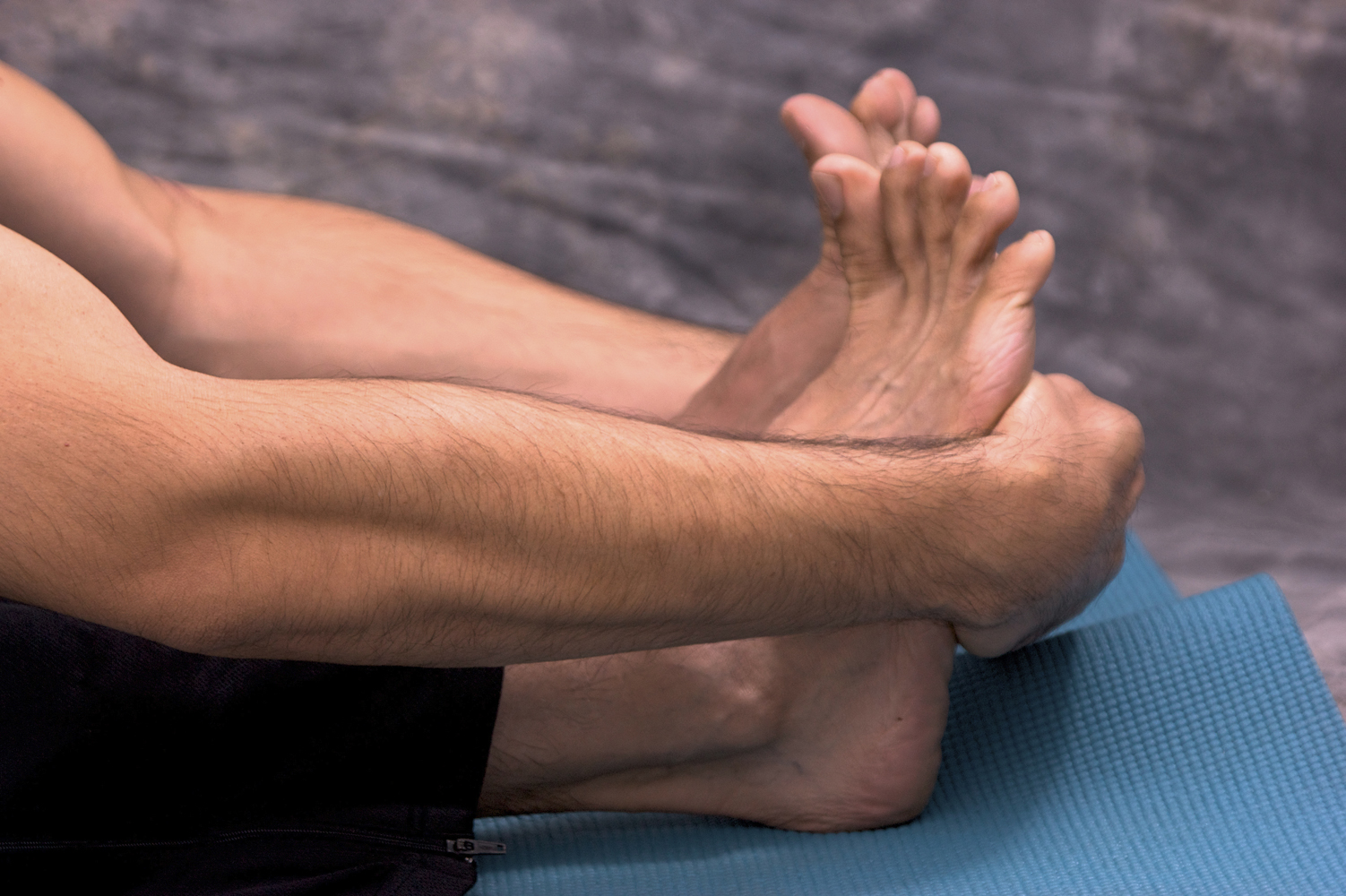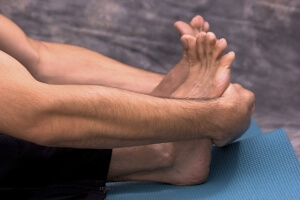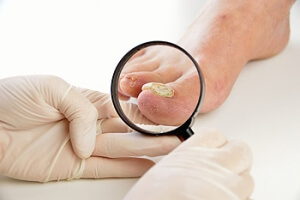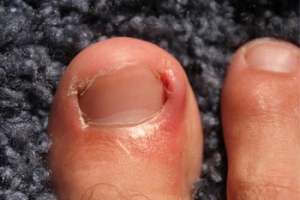
Heel Spurs
Heel spurs are the result of calcium deposits that cause bony protrusions on the underside of the heel. Heel spurs are usually painless, but they have the potential to cause heel pain. Heel spurs tend to be associated with plantar fasciitis, which is a condition that causes inflammation of the band of connective tissue that runs along the bottom of the foot. They most often occur to athletes whose sports involve a lot of running and jumping.
Some risk factors for developing heel spurs include running and jogging on hard surfaces, being obese, wearing poorly fitting shoes, or having walking gait abnormalities.
It is possible to have a heel spur without showing signs of any symptoms. However, if inflammation develops at the point of the spur’s formation, you may have pain while walking or running. In terms of diagnosis, sometimes all a doctor needs to know is that the patient is experiencing a sharp pain localized to the heel to diagnose a heel spur. Other times, an x-ray may be needed to confirm the presence of a heel spur.
Heel spurs can be prevented by wearing well-fitting shoes that have shock-absorbent soles. You should also be sure that you are choosing the right shoe for the activity you want to partake in; for example, do not wear walking shoes when you want to go on a run. Additionally, maintaining a healthy weight can be beneficial toward preventing heel spurs, as it will prevent an excess amount of pressure being placed on the ligaments.
There are a variety of treatment options for people with heel spurs. Some of these include stretching exercises, physical therapy, shoe inserts, or taping and strapping to rest stressed muscles and tendons. If you have heel pain that lasts longer than a month, don’t hesitate to seek help from a podiatrist. Your doctor can help you determine which treatment option is best for you.
How Yoga Can Benefit the Feet
 When proper foot stretches are practiced, the feet and general well being of the body is enhanced. One of the ways this can be achieved is by performing yoga stretches that may strengthen the tendons and muscles, resulting in the feet becoming flexible. This can aid in making daily activities easier to perform and may possibly eliminate any achy feeling the feet may endure. Recent research has shown that yoga may help to develop balance in the feet, extending to the rest of the body. A stretch that is known as “weaving” may help to diminish symptoms of bunions. This is performed by weaving the fingers between the toes while gently massaging the ball of the foot. To strengthen the arch in the foot, towel scrunches are an effective method of accomplishing this, and may also provide relief in relieving symptoms of plantar fasciitis. It’s suggested to consult with a podiatrist for additional knowledge on how to perform proper foot stretches.
When proper foot stretches are practiced, the feet and general well being of the body is enhanced. One of the ways this can be achieved is by performing yoga stretches that may strengthen the tendons and muscles, resulting in the feet becoming flexible. This can aid in making daily activities easier to perform and may possibly eliminate any achy feeling the feet may endure. Recent research has shown that yoga may help to develop balance in the feet, extending to the rest of the body. A stretch that is known as “weaving” may help to diminish symptoms of bunions. This is performed by weaving the fingers between the toes while gently massaging the ball of the foot. To strengthen the arch in the foot, towel scrunches are an effective method of accomplishing this, and may also provide relief in relieving symptoms of plantar fasciitis. It’s suggested to consult with a podiatrist for additional knowledge on how to perform proper foot stretches.
Stretching the feet is a great way to prevent injuries. If you have any concerns with your feet consult with one of our podiatrists from Sayville Foot Care. Our doctors will assess your condition and provide you with quality foot and ankle treatment.
Stretching the Feet
Stretching the muscles in the foot is an important part in any physical activity. Feet that are tight can lead to less flexibility and make you more prone to injury. One of the most common forms of foot pain, plantar fasciitis, can be stretched out to help ease the pain. Stretching can not only ease pain from plantar fasciitis but also prevent it as well. However, it is important to see a podiatrist first if stretching is right for you. Podiatrists can also recommend other ways to stretch your feet. Once you know whether stretching is right for you, here are some excellent stretches you can do.
- Using a foam roller or any cylindrical object (a water bottle or soda can will do), roll the object under your foot back and forth. You should also exert pressure on the object. Be sure to do this to both feet for a minute. Do this exercise three times each.
- Similar to the previous one, take a ball, such as a tennis ball, and roll it under your foot while seated and exert pressure on it.
- Grab a resistance band or towel and take a seat. If you are using a towel, fold it length wise. Next put either one between the ball of your foot and heel and pull with both hands on each side towards you. Hold this for 15 seconds and then switch feet. Do this three times for each foot.
- Finally hold your big toe while crossing one leg over the other. Pull the toe towards you and hold for 15 seconds. Once again do this three times per foot.
It is best to go easy when first stretching your foot and work your way up. If your foot starts hurting, stop exercising and ice and rest the foot. It is advised to then see a podiatrist for help.
If you have any questions, please feel free to contact our office located in Sayville, NY . We offer the newest diagnostic and treatment technologies for all your foot care needs.
Stretching Your Feet
Debilitating foot pain is a problem for many people. But just as stretching the torso can help alleviate back pain, stretching the feet can also help mend existing foot problems and prevent future ones.
The feet, as the body’s foundation, carry the body’s entire weight and can get easily strained from overexertion. Persistent sharp pain and cramping in the feet are often common concerns. Foot pain and foot problems can be due to any number of causes, and in many cases pain may be eased without medication or doctor visits. It is always a good idea, however, to first rule out any serious medical issues with a physician.
Stretching can help relax the feet and alleviate pain, but is especially important before heavy aerobic exercise. Stretching before such activities can help you avoid experiencing painful cramps or strained foot muscles. Stretches should be performed slowly and deliberately without forceful pulling. The stretch should be held for several seconds before relaxing.
A great way to stretch out and loosen up the foot muscles while sitting is to cross one leg over the other and pull the toes carefully back without overextending. Start by resting the left ankle on the right knee. With the left hand, gently flex the left foot by pulling back on the toes. Do not pull too hard; just hard enough to feel the stretch in the arch of the foot. Then point the toes of the left foot as far as you can. Rotate the motion of pointing with pulling back on the toes. This should relax and stretch the muscles on the bottom and the top of the foot. Doing this stretch ten to twenty times should bring relief. Repeat the whole process for the other foot by resting the right ankle on the left knee.
A stretch that focuses on the often injured Achilles tendon involves standing and facing a wall with your arms out and hands flat against the wall. Step back with one foot, keeping it flat against the floor. Move the other leg forward and lean toward the wall. You should feel a stretch through the back of your leg and your Achilles tendon, but do not push yourself too much. Stop when you feel a stretching sensation, and hold for 30 seconds. Ten repetitions may be done for each foot.
Stretching the feet is important for athletes or those performing aerobic exercise, but it can also help anyone with foot pain caused by poor footwear, plantar fasciitis, or long hours standing and walking. Individuals who tend to their feet by regularly stretching every day should be able to minimize foot pain and prevent new problems from arising.
Causes of Toenail Fungus
 Toenail fungus is a common ailment and may typically be noticed by the yellowing and thickening of the affected toenail. If left untreated, the nail may gradually turn black and may cause an unsightly appearance. There may be several reasons for this condition to occur, including sweaty feet caused by wearing shoes that do not allow enough air to circulate, or enduring specific health issues such as psoriasis or diabetes. The toenail fungus may cause an infection, and it’s suggested to consult with a podiatrist if the infection should become severe. A proper diagnosis can be performed, which may include testing a portion of the nail to determine the exact cause of the infection followed by discussing correct treatment options.
Toenail fungus is a common ailment and may typically be noticed by the yellowing and thickening of the affected toenail. If left untreated, the nail may gradually turn black and may cause an unsightly appearance. There may be several reasons for this condition to occur, including sweaty feet caused by wearing shoes that do not allow enough air to circulate, or enduring specific health issues such as psoriasis or diabetes. The toenail fungus may cause an infection, and it’s suggested to consult with a podiatrist if the infection should become severe. A proper diagnosis can be performed, which may include testing a portion of the nail to determine the exact cause of the infection followed by discussing correct treatment options.
If left untreated, toenail fungus may spread to other toenails, skin, or even fingernails. If you suspect you have toenail fungus it is important to seek treatment right away. For more information about treatment, contact one of our podiatrists of Sayville Foot Care. Our doctors can provide the care you need to keep you pain-free and on your feet.
Symptoms
- Warped or oddly shaped nails
- Yellowish nails
- Loose/separated nail
- Buildup of bits and pieces of nail fragments under the nail
- Brittle, broken, thickened nail
Treatment
If self-care strategies and over-the-counter medications does not help your fungus, your podiatrist may give you a prescription drug instead. Even if you find relief from your toenail fungus symptoms, you may experience a repeat infection in the future.
Prevention
In order to prevent getting toenail fungus in the future, you should always make sure to wash your feet with soap and water. After washing, it is important to dry your feet thoroughly especially in between the toes. When trimming your toenails, be sure to trim straight across instead of in a rounded shape. It is crucial not to cover up discolored nails with nail polish because that will prevent your nail from being able to “breathe”.
In some cases, surgical procedure may be needed to remove the toenail fungus. Consult with your podiatrist about the best treatment options for your case of toenail fungus.
If you have any questions, please feel free to contact our office located in Sayville, NY . We offer the newest diagnostic and treatment technologies for all your foot care needs.
Toenail Fungus
Toenail fungus is a frustrating problem that affects many people. It can be persistent and hard to get rid of. As many different types of fungi are present throughout the environment, it is very easy to contract toenail fungus.
The feet are especially susceptible to toenail fungus because shoes and socks create the ideal dark and moist environment that fungal infections thrive in. While fungal infections of the nail plate are quite common, if left untreated they can spread beyond the toenail and into the skin and other parts of the body.
Signs of toenail fungus include a thickened nail that has become yellow or brown in color, a foul smell, and debris beneath the nail. The toe may become painful due to the pressure of a thicker nail or the buildup of debris.
Treatment for toenail fungus is most effective during the early stages of an infection. If there is an accumulation of debris beneath the nail plate, an ingrown nail or a more serious infection can occur. While each treatment varies between patients, your podiatrist may prescribe you oral medications, topical liquids and creams, or laser therapy. To determine the best treatment process for you, be sure to visit your podiatrist at the first signs of toenail fungus.
The Definition of a Podiatrist
 A doctor that specializes in disorders of the foot is referred to as a podiatrist. This type of doctor typically treats foot conditions including hammer toe, bunions and ingrown toenails. They may also treat foot ailments caused by birth defects such as clubfoot and flat feet. Diabetic patients often notice sores on their feet, which may heal slowly, and this may be one of the first symptoms indicating this condition exists. Within this field, there are categories specific to the type of patient that is being treated. For instance, podiatrists who specialize in sports medicine typically treat athletes. Doctors who are skilled in advanced surgery may perform foot and ankle reconstruction, which may be a necessary option after an injury. If you have any questions regarding podiatry, please consult with your podiatrist.
A doctor that specializes in disorders of the foot is referred to as a podiatrist. This type of doctor typically treats foot conditions including hammer toe, bunions and ingrown toenails. They may also treat foot ailments caused by birth defects such as clubfoot and flat feet. Diabetic patients often notice sores on their feet, which may heal slowly, and this may be one of the first symptoms indicating this condition exists. Within this field, there are categories specific to the type of patient that is being treated. For instance, podiatrists who specialize in sports medicine typically treat athletes. Doctors who are skilled in advanced surgery may perform foot and ankle reconstruction, which may be a necessary option after an injury. If you have any questions regarding podiatry, please consult with your podiatrist.
If you are dealing with pain in your feet and ankles, you may want to seek help from a podiatrist. Feel free to contact one of our podiatrists from Sayville Foot Care. Our doctors can provide the care you need to keep you pain-free and on your feet.
What Is a Podiatrist?
A podiatrist is a doctor of podiatric medicine who diagnoses and treats conditions of the foot, ankle, and related structures of the leg. Your podiatrist may specialize in a certain field such as sports medicine, wound care, pediatrics, and diabetic care. Podiatrists have the ability to become board certified through training, clinical experience, and then taking an exam.
What Do Podiatrists Do?
On a daily basis, a podiatrist may perform the following activities:
- Diagnose foot ailments such as ulcers, tumors, fractures, etc.
- Use innovative methods to treat conditions
- Use corrective orthotics, casts, and strappings to correct deformities
- Correct walking patterns and balance
- Provide individual consultations to patients
It is very important that you take care of your feet. It’s easy to take having healthy feet for granted, however foot problems tend to be among the most common health conditions. Podiatrists can help diagnose and treat a variety of feet related conditions, so it is crucial that you visit one if you need assistance.
If you have any questions please feel free to contact our office located in Sayville, NY . We offer the newest diagnostic and treatment technologies for all your foot and ankle needs.
What is a Podiatrist?
The branch of medicine that is focused on the treatment, diagnosis, and study of disorders of the lower leg, ankle and foot is referred to as podiatry. Because people often spend a great deal of their time on their feet, many problems in this area can occur. A person seeks help from the field of podiatry when they need treatment for heel spurs, bunions, arch problems, deformities, ingrown toenails, corns, foot and ankle problems, infections, and problems with the foot that are related to diabetes and additional diseases.
To treat problems of the foot, ankle or lower leg, a podiatrist may prescribe physical therapy, drugs, perform surgery, or set fractures. Individuals may also be recommended to wear corrective shoe inserts, custom-made shoes, plaster casts and strappings in order to correct deformities.
When trying to gather information on a patient problem, a scanner or force plate may be used in order to design orthotics. During this procedure, patients are told to walk across a plate that is connected to a computer; the computer then takes a scan of the foot and indicates weight distribution and pressure points. The computer readouts will give the podiatrist information to help them determine the correct treatment plans.
Diagnosis is also provided through laboratory tests and x-rays. Through the foot, the first signs of serious problems such as heart disease, diabetes and arthritis can show up. For example, individuals that have diabetes may frequently have problems such as infections and foot ulcers because they experience poor circulation in the foot area. A podiatrist can then have consultations with patients when symptoms arise. Referrals will then be made to specialists that handle the greater health problems.
Some podiatrists have their own independent, private practices or clinics where they have a small staff and administrative personnel. Many podiatrists work within group practices. They usually spend time performing surgery in ambulatory surgical centers or hospitals, or visit patients in nursing homes. Podiatrists typically spend between 30 to 60 hours of week working. Some podiatrists specialize in public health, orthopedics, surgery, or primary care. Other fields include specialties in geriatrics, dermatology, pediatrics, diabetic foot care and sports medicine.
Some podiatrist specialists complete extra training in the area of foot and ankle reconstruction that results from the effects of physical trauma or diabetes. There are also surgeons that perform surgery of a cosmetic nature to correct bunions and hammertoes.
Causes of Ingrown Toenails
 The pain of an ingrown toenail can often be uncomfortable and frustrating, and will typically affect the big toe. It generally occurs when the nails are not trimmed correctly, which may cause the side of the nail to grow downward. Additionally, an ingrown toenail may result from wearing shoes that fit poorly. Common symptoms may include the toe appearing red and tender and in severe cases, a discharge may ooze from the affected and surrounding areas. Many patients will benefit from consulting with a podiatrist who may suggest soaking the foot in lukewarm salt water several times per day. This method will soften the skin which may attain moderate relief. If the toenail becomes infected, surgery may be a necessary treatment option for removal of the nail and the infected surrounding tissue. If you would like additional information about how to prevent or treat ingrown toenails, please consult with a podiatrist
The pain of an ingrown toenail can often be uncomfortable and frustrating, and will typically affect the big toe. It generally occurs when the nails are not trimmed correctly, which may cause the side of the nail to grow downward. Additionally, an ingrown toenail may result from wearing shoes that fit poorly. Common symptoms may include the toe appearing red and tender and in severe cases, a discharge may ooze from the affected and surrounding areas. Many patients will benefit from consulting with a podiatrist who may suggest soaking the foot in lukewarm salt water several times per day. This method will soften the skin which may attain moderate relief. If the toenail becomes infected, surgery may be a necessary treatment option for removal of the nail and the infected surrounding tissue. If you would like additional information about how to prevent or treat ingrown toenails, please consult with a podiatrist
Ingrown toenails may initially present themselves as a minor discomfort, but they may progress into an infection in the skin without proper treatment. For more information about ingrown toenails, contact one of our podiatrists of Sayville Foot Care. Our doctors can provide the care you need to keep you pain-free and on your feet.
Ingrown Toenails
Ingrown toenails are caused when the corner or side of a toenail grows into the soft flesh surrounding it. They often result in redness, swelling, pain, and in some cases, infection. This condition typically affects the big toe and may recur if it is not treated properly.
Causes
- Improper toenail trimming
- Genetics
- Improper shoe fitting
- Injury from pedicures or nail picking
- Abnormal gait
- Poor hygiene
You are more likely to develop an ingrown toenail if you are obese, have diabetes, arthritis, or have any fungal infection in your nails. Additionally, people who have foot or toe deformities are at a higher risk of developing an ingrown toenail.
Symptoms
Some symptoms of ingrown toenails are redness, swelling, and pain. In rare cases, there may be a yellowish drainage coming from the nail.
Treatment
Ignoring an ingrown toenail can have serious complications. Infections of the nail border can progress to a deeper soft-tissue infection, which can then turn into a bone infection. You should always speak with your podiatrist if you suspect you have an ingrown toenail, especially if you have diabetes or poor circulation.
If you have any questions, please feel free to contact our office located in Sayville, NY . We offer the newest diagnostic and treatment technologies for all your foot care needs.
Ingrown Toenail Care
An ingrown toenail is a toenail that grows sideways into the nail bed, causing pain and swelling. Ingrown toenails can worsen and cause drainage, turning into a serious infection.
Several factors affect whether a person is at risk from an ingrown toenail. The many causes include being overweight, diabetes, participating in sports, having a fungal infection of the toe, and cutting your nails too short. Ingrown toenails also have a genetic predisposition, causing some people to be more prone to receive the condition than others. Other causes include improperly fitting shoes and shoes that keep the feet damp.
Ingrown toenails can be preventable with certain measures. For starters, allowing your toe nails to grow slightly longer in length will help prevent them from becoming ingrown. If you have already developed an ingrown toenail, soak the affected toe in warm water. This will alleviate the pain and help prevent an infection from forming. Antibiotic soap or Epsom salts may be added to further help the relieving process and avoid infection. Placing cotton beneath the affected area is also suggested, as this may help the toenail grow upwards and not into the nail bed. Swelling and redness can be reduced by resting with your feet elevated.
A podiatrist should be seen if the pain becomes so serious that it prevents you from doing your everyday activities. If a red streak running up your leg appears or if you suspect your infection has spread, contact a podiatrist immediately. Fast treatments can be undertaken to lessen your pain and have you walking comfortably.
An ingrown toenail can be easily treated with a Band-Aid. Simply wrap the affected toe with a Band-Aid to prevent infection and keep the nail from growing out at a painful angle.
In more serious cases, your podiatrist may decide to make a small incision to remove a portion of your toenail. To prevent the nail from growing back, medication will be placed directly into the nail bed. This procedure would be performed under local anesthesia and is a faster method to alleviate discomfort from an ingrown toenail. Post-procedure directions will have you stay off the affected foot for a day. Afterwards, normal activities can be resumed.
Are Swollen Feet and Ankles Normal During Pregnancy?
 Many women often experience swollen feet and ankles during their pregnancy. This is commonly referred to as edema. Generally, the swelling is a result of the excess fluid in the body caused by the developing fetus and may become severe during the third trimester. There are several ways to reduce any swelling that may develop in the feet and ankles, including stretching the legs as often as possible, elevating the feet, and limiting standing for extended periods of time. Research has shown that it may be beneficial to lie on the left side while sleeping in addition to consuming plenty of fresh water, which may help to avoid dehydration. It's suggested to speak with a podiatrist who can answer any questions you may have regarding any severe swelling in your feet.
Many women often experience swollen feet and ankles during their pregnancy. This is commonly referred to as edema. Generally, the swelling is a result of the excess fluid in the body caused by the developing fetus and may become severe during the third trimester. There are several ways to reduce any swelling that may develop in the feet and ankles, including stretching the legs as often as possible, elevating the feet, and limiting standing for extended periods of time. Research has shown that it may be beneficial to lie on the left side while sleeping in addition to consuming plenty of fresh water, which may help to avoid dehydration. It's suggested to speak with a podiatrist who can answer any questions you may have regarding any severe swelling in your feet.
Pregnant women with swollen feet can be treated with a variety of different methods that are readily available. For more information about other cures for swollen feet during pregnancy, consult with one of our podiatrists from Sayville Foot Care. Our doctors will attend to all of your foot and ankle needs.
What Foot Problems Can Arise During Pregnancy?
One problem that can occur is overpronation, which occurs when the arch of the foot flattens and tends to roll inward. This can cause pain and discomfort in your heels while you’re walking or even just standing up, trying to support your baby.
Another problem is edema, or swelling in the extremities. This often affects the feet during pregnancy but tends to occur in the later stages.
How Can I Keep My Feet Healthy During Pregnancy?
- Wearing orthotics can provide extra support for the feet and help distribute weight evenly
- Minimize the amount of time spent walking barefoot
- Wear shoes with good arch support
- Wear shoes that allow for good circulation to the feet
- Elevate feet if you experience swelling
- Massage your feet
- Get regular, light exercise, such as walking, to promote blood circulation to the feet
If you have any questions please feel free to contact our office located in Sayville, NY . We offer the newest diagnostic and treatment technologies for all your foot and ankle needs.





